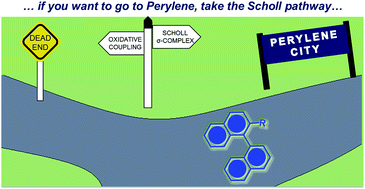Arenium cation or radical cation? An insight into the cyclodehydrogenation reaction of 2-substituted binaphthyls mediated by Lewis acids†
Abstract
Perylene and its derivatives are some of the most interesting chromophores in the field of molecular design. One of the most employed methodologies for their synthesis is the cyclodehydrogenation of binaphthyls mediated by Lewis acids. In this article, we investigated the cyclodehydrogenation reaction of 2-substituted binaphthyls to afford the bay-substituted perylene. By using AlCl3 as a Lewis acid and high temperatures (the Scholl reaction), two new products bearing NH2 and N(CH3)2 groups at position 2 of the perylene ring were synthesized. Under these conditions, we were also able to obtain terrylene from ternaphthalene in 38% yield after two cyclodehydrogenation reactions in a single step. The attempts to promote the formation of a radical cation (necessary intermediary for the oxidative aromatic coupling mechanism) by using FeCl3 or a strong oxidant like 2,3-dichloro-5,6-dicyano-1,4-benzoquinone (DDQ) did not yield the expected products. DFT calculations suggested that the lack of reaction for oxidative aromatic coupling is caused by the difference between the oxidation potentials of the donor/acceptor couple. In the case of the Scholl reaction, the regiochemistry involved in the formation of the σ-complex together with the activation energy of the C–C coupling reaction helped to explain the differences in the reactivity of the different substrates studied.



 Please wait while we load your content...
Please wait while we load your content...